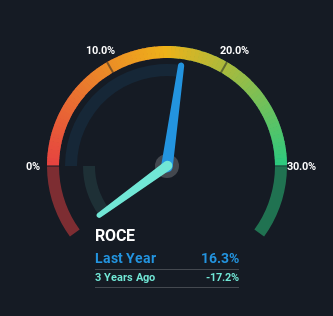
If we want to find a stock that could multiply over the long term, what are the underlying trends we should look for? In a perfect world, we'd like to see a company investing more capital into its business and ideally the returns earned from that capital are also increasing. Ultimately, this demonstrates that it's a business that is reinvesting profits at increasing rates of return. Speaking of which, we noticed some great changes in Kirloskar Electric's (NSE:KECL) returns on capital, so let's have a look.
What Is Return On Capital Employed (ROCE)?
For those that aren't sure what ROCE is, it measures the amount of pre-tax profits a company can generate from the capital employed in its business. The formula for this calculation on Kirloskar Electric is:
Return on Capital Employed = Earnings Before Interest and Tax (EBIT) ÷ (Total Assets - Current Liabilities)
0.16 = ₹317m ÷ (₹6.4b - ₹4.5b) (Based on the trailing twelve months to March 2024).
So, Kirloskar Electric has an ROCE of 16%. That's a relatively normal return on capital, and it's around the 17% generated by the Electrical industry.
See our latest analysis for Kirloskar Electric

Historical performance is a great place to start when researching a stock so above you can see the gauge for Kirloskar Electric's ROCE against it's prior returns. If you'd like to look at how Kirloskar Electric has performed in the past in other metrics, you can view this free graph of Kirloskar Electric's past earnings, revenue and cash flow.
What The Trend Of ROCE Can Tell Us
The fact that Kirloskar Electric is now generating some pre-tax profits from its prior investments is very encouraging. About five years ago the company was generating losses but things have turned around because it's now earning 16% on its capital. And unsurprisingly, like most companies trying to break into the black, Kirloskar Electric is utilizing 880% more capital than it was five years ago. We like this trend, because it tells us the company has profitable reinvestment opportunities available to it, and if it continues going forward that can lead to a multi-bagger performance.
In another part of our analysis, we noticed that the company's ratio of current liabilities to total assets decreased to 70%, which broadly means the business is relying less on its suppliers or short-term creditors to fund its operations. This tells us that Kirloskar Electric has grown its returns without a reliance on increasing their current liabilities, which we're very happy with. Nevertheless, there are some potential risks the company is bearing with current liabilities that high, so just keep that in mind.
In Conclusion...
In summary, it's great to see that Kirloskar Electric has managed to break into profitability and is continuing to reinvest in its business. And with the stock having performed exceptionally well over the last five years, these patterns are being accounted for by investors. With that being said, we still think the promising fundamentals mean the company deserves some further due diligence.
If you want to know some of the risks facing Kirloskar Electric we've found 3 warning signs (2 shouldn't be ignored!) that you should be aware of before investing here.
While Kirloskar Electric isn't earning the highest return, check out this free list of companies that are earning high returns on equity with solid balance sheets.
If you're looking to trade Kirloskar Electric, open an account with the lowest-cost platform trusted by professionals, Interactive Brokers.
With clients in over 200 countries and territories, and access to 160 markets, IBKR lets you trade stocks, options, futures, forex, bonds and funds from a single integrated account.
Enjoy no hidden fees, no account minimums, and FX conversion rates as low as 0.03%, far better than what most brokers offer.
Sponsored ContentValuation is complex, but we're here to simplify it.
Discover if Kirloskar Electric might be undervalued or overvalued with our detailed analysis, featuring fair value estimates, potential risks, dividends, insider trades, and its financial condition.
Access Free AnalysisHave feedback on this article? Concerned about the content? Get in touch with us directly. Alternatively, email editorial-team (at) simplywallst.com.
This article by Simply Wall St is general in nature. We provide commentary based on historical data and analyst forecasts only using an unbiased methodology and our articles are not intended to be financial advice. It does not constitute a recommendation to buy or sell any stock, and does not take account of your objectives, or your financial situation. We aim to bring you long-term focused analysis driven by fundamental data. Note that our analysis may not factor in the latest price-sensitive company announcements or qualitative material. Simply Wall St has no position in any stocks mentioned.
About NSEI:KECL
Kirloskar Electric
Engages in the manufacturing and sale of various electrical equipment in India and internationally.
Slight with mediocre balance sheet.
Similar Companies
Market Insights
Community Narratives




